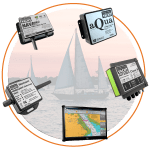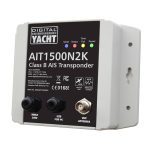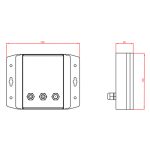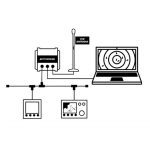AIT1500N2K – AIS Transponder with built-in GPS & NMEA 2000
“An easy to install Class B AIS transponder with plug ‘n play NMEA 2000 interface. Built in GPS antenna and ideal for use on smaller yachts and boats like RIBs and center consoles.”
KEY FEATURES

The AIT1500N2K is a Class B AIS transponder with NMEA 2000 interface and built in GPS antenna to make installation as easy as possible. The super sensitive design allows below deck mounting on GRP boats such as small yachts, RIBs and center consoles and cuts down on antenna clutter. It connects to your boat’s electronics via a plug ‘n play NMEA 2000 connection and power is also taken from the NMEA 2000 backbone. Simply connect a VHF antenna (or use our SPL2000 AIS-VHF antenna splitter) and you’re equipped with Class B AIS transponder.
Once installed, your AIS compatible plotter will show an overlay of targets and you’ll transmit your position every 30 seconds when underway to other AIS users. For PC/MAC connectivity there is also a USB interface. This can also be used for programming the transponder with your boat details.
The AIT1500N2K features a waterproof and tough enclosure with 4 LED indicators to show the status of the transponder.
SPECIFICATIONS
- Class B AIS transponder with NMEA 2000 interface and built in GPS antenna
- Shares the same latest generation AIS technology as our AIT2000 and AIT3000 units
- Plug and Play NMEA2000 interface (takes power from network)
- Compatible with all AIS ready chart plotters
- Internal GPS antenna for easy installation on fibreglass (GRP) hulled boats
- Built-in high performance 50 channel GPS receiver (ideal also as a backup GPS)
- USB Interface for simple plug and play connection to a PC or Mac
- Requires VHF antenna or dedicated AIS antenna (available as optional accessory) or splitter (SPL2000)
- Supplied with programming software for PC/Mac and SmarterTrack Lite for Windows
- Easy to install black box solution
| Weight | 610 g |
|---|---|
| Dimensions | 245 × 165 × 100 mm |
ProAIS2 V1.20 Mac OSX Zip
8.43 MBproAIS2 for Mac, the configuration and diagnostics software for our latest AIT1500/2000/2500/3000/5000 and Nomad transponders.
ProAIS2 V1.20 Windows Zip
9.24 MBproAIS2 for Windows, the configuration and diagnostics software for our latest AIT1500/2000/2500/3000/5000 and Nomad transponders.
AIT1500N2K Quick Start V1 01 Eng Pdf
662.79 KBAIT1500N2K Latest Quick Start Manual (English)
An AIS which sends and receives data is known as a transceiver (or often called a transponder). There are also simple devices called AIS receivers which pick up transmissions and decode for displaying on a compatible chart plotter or PC based navigation system – or even an iPad or tablet.
AIS transponders will allow you to receive data from vessels close to you, but will also allow you to continuously transmit your vessel’s identity, position, speed and heading, as well as other relevant information, to all other AIS-equipped vessels within your range.
To transmit its position, an AIS transponder must have its own GPS antenna. All our AIS transponders are supplied with a GPS antenna or have a built-in GPS antenna.
With an AIS receiver or transponder, you will receive all information of surrounding ships and will allow you to contact them directly. There are 3 types of AIS data that are automatically and continuously transmitted:
- Dynamic data: position and speed which are automatically calculated by the transponder.
- Static data: MMSI, ship name, size and contact details. This data is programmed on the device.
- Voyage data (only for class A transponder): Destination, ETA, number on board and navigation status. This data is programmed on the class A transponder before and during each voyage.
The data transmission frequency is different depending on the transponder category and the speed of the ship.
The AIS targets can be displayed in different ways:
- On a multifunction plotter/screen using the NMEA interface of an AIS receiver/transponder.
- On a PC/MAC navigation software thanks to a NMEA/USB adapter or an AIS receiver/transponder with an integrated USB interface.
- On an iOS/Android navigation application via a NMEA to WiFi server or an AIS receiver/transponder with integrated WiFi interface.
Each system will display the AIS targets differently (colours, size, etc.) but the data will remain the same. The next tab will explain which AIS transponder you need depending on the system you want to use to display the AIS targets.
To help you choose the right AIS transponder for you, here are a few keys that may help you out:
- Receive targets on a plotter – if you want to receive only AIS targets on a plotter then you have the choice between the AIT1500, AIT1500N2K, AIT2000 and AIT2500. The AIT1500 or AIT1500N2K have a GPS built into the transponder and is therefore recommended for fibreglass boats up to 30 feet. The AIT1500 only has an NMEA 0183 interface while the AIT1500N2K has a NMEA 2000 interface. The AIT2000 (class B) and AIT2500 (class B+) both have an external GPS antenna and can therefore be installed on any type of boat. They both also have an NMEA 0183, NMEA 2000 and USB interface.
- Receive AIS targets on software or applications – If you only want to receive AIS targets on navigation software or applications, then we recommend the iAISTX. This is an AIS transponder with an external GPS antenna and a built-in WiFi server.
- Receive AIS targets on a plotter AND software/applications – To receive AIS targets on a plotter and software/applications at the same time, we recommend the AIT5000 (Class B+). The AIT5000 is the most complete AIS transponder with a certified zero loss VHF antenna splitter, NMEA multiplexer, external GPS antenna and WiFi server.
- AIS for rental boats – if you are looking for an AIS receiver or transponder that you can put in your suitcase and want to use when renting a boat then the Nomad is the right AIS transponder for the job. It is the only portable AIS transponder that has a built-in GPS, is USB powered and comes with a portable VHF antenna.
Now that you have an idea of which AIS transponder you need, you will also need to choose between Class B or Class B+ AIS transponder.
There are 3 types of AIS transponders: Class A, Class B and Class B+ :
- Class B AIS Transponder is for recreational craft installation and is a simplified, lower powered 2W transceiver which is normally a black box and uses a connected chart plotter to display local AIS targets. It transmits every 30 seconds regardless of vessel speed and can’t transmit additional data like destination port.
- Class B+ AIS Transponder (also called Class B SOTDMA or Class B 5W ) is a new standard that utilises SOTDMA format transmissions which offer a 5W power output (2.5 x more powerful than a regular Class B), a guaranteed time slot for transmission in busy traffic areas and faster update rates depending upon the speed of the vessel. It’s ideal for ocean sailors requiring the best possible performance and future proof satellite tracking applications, fast power boats and smaller non-mandated commercial vessels.
- Class A AIS Transponder must have a dedicated (and type approved) display to show the location of nearby AIS targets and transmits at 12.5W. Data is sent at up to every 2 seconds depending upon the vessel speed and the display also allows for data to be inputted to the transmission such as vessel destination. A Class A device is normally used on commercial vessels as its Type Approved to IMO specifications.
If the AIS transponder doesn’t have a built-in VHF splitter (i.e. AIT5000), there are 2 options: either install a dedicated VHF antenna for AIS or install an antenna splitter so that the main VHF antenna is used for both VHF radio and AIS.
For those who want to use their existing VHF antenna, then we recommend the use of a certified zero loss VHF antenna splitter such as our SPL1500 and SPL2000. Please do not use a non-zero loss certified VHF antenna splitter. They are inexpensive, but they can destroy your AIS transponder.
For those who want to install a VHF antenna dedicated to AIS, then we recommend a VHF antenna tuned to AIS frequencies. The AIS transmission and reception works on 2 dedicated channels which use the frequencies 161.975 and 162.025 MHz (channel 87B and 88B). VHF frequencies in the maritime environment use frequencies from 156.0 to 162.025 MHz and most VHF antennas are designed to provide maximum gain on channel 16 (156.8 MHz). You can now find antennas on the market dedicated to AIS frequencies such as the HA156 antenna.
These antennas, dedicated to AIS frequencies, offer maximum gain at 162 MHz (which is the centre between the 2 AIS frequencies 161.975 and 162.025 MHz). So if you install a VHF antenna instead of a VHF antenna splitter for your AIS receiver or transponder, then choose an AIS frequency VHF antenna to compensate for the loss due to the installation of the antenna lower down than the main VHF antenna at the top of the mast. The graph below shows how a dedicated AIS frequency antenna (162 MHz) provides a better VSWR and therefore a better transmission and reception.
The AIS transponder can be configured with the free PC/Mac software called ProAIS2. The ProAIS2 software can be downloaded free of charge directly from our website. The functionality of the proAIS2 software is the same on Windows or Mac.
Installation of the proAIS2 software, also installs the USB drivers and we recommend not plugging the transponders USB cable in to the PC/Mac until after you have installed proAIS2. Once the installation is complete, plug the USB cable in to the computer to complete the USB driver installation. The transponder receives enough power from the USB connection to power the processor and ancillory circuitry required to configure the transponder, however the GPS will not get a fix, the NMEA interfaces will not be working and the transponder will not transmit while on USB power.
Digital Yacht are not the only company that supply proAIS2 with transponders, but to our knowledge, we are the only company to produce a video showing how to configure and diagnose Class B transponders with it. So we hope that not only Digital Yacht users but owners of other brands will benefit from this video.
Please note that the MMSI number cannot be changed once the product has been configured. To change the MMSI number, you must reset the product and for that, please contact us.
To find out how to use the proAIS2 software to configure an AIS transponder, please watch the video below: https://www.youtube.com/watch?v=FTiMynP8KDs
If you want to stop transmitting your position, you can either fit a physical silent switch on the AIS transponder or you can stop the AIS transmission through the ProAIS2 software.
This is a very valid question. Especially if you have spent a few hours installing the transponder then knowing that it is working OK is very important. Using the proAIS2 configuration software allows you to see if the GPS position is OK. You can monitor the AIS reception of other vessels. As well as ensure that there are no errors or alarms. However, if you are new to AIS, there is always that nagging doubt as to whether other vessels are seeing you.
The best test of a Class B transponder is to ask someone else in your marina, who has AIS, to check that they are receiving you on their system. If your vessel is stationary, then a transponder will only transmit every 3 minutes. This increases to every 30 seconds when your speed over the ground (SOG) is greater than 2 knots. Therefore, do allow some time for them to detect you. Also when they first receive your transmission, the only data they will see is your position, speed, course and MMSI number. It can take up to 6 minutes to receive your “Static Data” (boat name, call sign, vessel type, dimensions, etc.). This is normal and is the way the AIS system regulates the amount of data being transmitted.
The other increasingly common method of testing an AIS transponder is to look on one of the online “live” AIS websites and the most popular of the free services is MarineTraffic.com
However, it is important for you to be aware of the limitations of these online sites. As a result, do not assume that you will always be picked up by them. Each of the different online services are only as good as their network of AIS receiving stations. In many cases enthusiasts/volunteers operate these. In some areas the coverage is great but there are definitely “holes” in coverage.
 United Kingdom
United Kingdom United States
United States France
France Australia
Australia Germany
Germany Spain
Spain Europe
Europe













